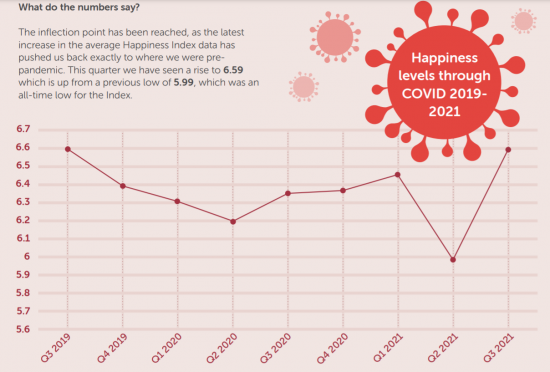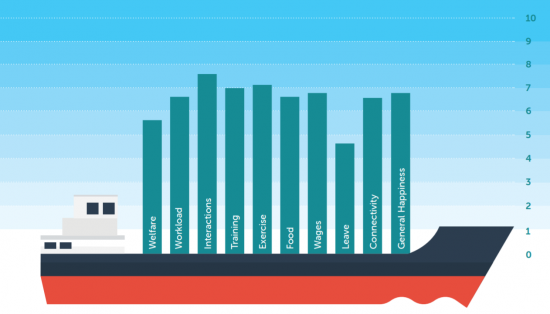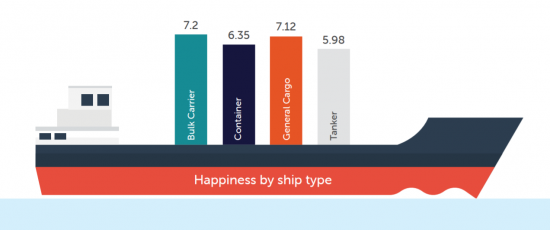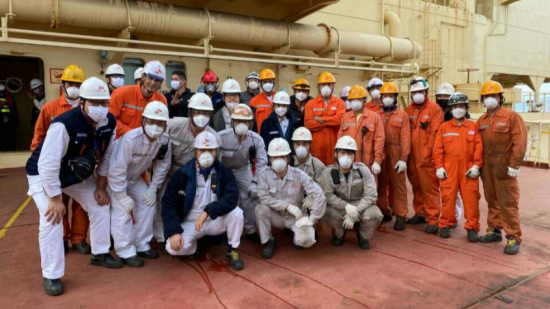The latest Q3 2021 Seafarer Happiness Index report demonstrates a better score: 6.59 out of 10 compared to the 5.99 result in Q2 2021 (an all-time low). Does that mean that jobs at sea have become more rewarding or that seafarers have finally reached the ‘acceptance’ stage; the one which comes after denial, anger, bargaining and depression?

The Seafarers Happiness Index is a constant barometer of the crewing situation in the world. We have described disastrous results of the previous poll in our Shipping Jobs in 2021 article, but the most recent report reflects some interesting tendencies.

Thus, it seems that the happiness rate has returned to exactly the same position it used to be at the end of Q3 2019. At the same time, an increasing number of seafarers want to quit the maritime industry for good. In addition, the shore leave problem along with ship-shore communication issues continue to be a constant source of pain and frustration for seafarers.
Who Is the Happiest Seafarer?
The SHI report is built on the aggregated data from the 90 leading shipping companies. The information provided is sufficient to paint a portrait of the most satisfied maritime professional in 2021:
1. Happy seafarer is probably female.
The level of happiness among female seafarers proves to be significantly higher (7.15 out of 10) compared to seamen (6.88). Although, we must admit that women constitute the minority of the SHI survey’s contributors; and 96% of respondents are male.
2. Contented seafarer is young.
To be precise, he/she is between 16 and 25 years old. The level of happiness in this group reaches 7.12 score which is in stark contrast to the 6.45 happiness rate among seafarers who are 55 – 65 years old (the least satisfied group).
This is a hopeful tendency demonstrating that the shipping industry does have a future. In fact, Q3 study has outlined an increased number of professionals who would like to quit their maritime career for good. Therefore, although seafarers are tired and frustrated at the moment, the new generation is still hopeful and eager to succeed.
3. Happy seafarer works on a bulk carrier.
There is an interesting fact that bulk carrier crews have composed the bulk of the study (52%) whilst showing the highest score (7.2).

Meanwhile, tanker ships’ crew appear to be the most miserable in the industry with only 5.98 happiness score out of 10.
4. Deck crew and bridge officers feel better than engine crew.
According to the study, bridge officers feel much happier than their Engine Room counterparts; the same goes for the deck and engine ratings.

5. Happy seafarer feels that he/she is understood by the company.
The question of connectivity has become extremely important in the past 20 months. Maritime professionals report exceedingly better sentiments when good internet connection is available in their cabins; thus enabling them to talk to their families. Companies that appreciate this need have more resilient and committed crews.
The second crucial connectivity matter concerns an ability of managers to treat their crew like adults when communicating with them. So, if the date of crew change is undetermined it is far better to say so rather than lie and feed homesick seafarers with false promises.
6. Happy seafarer feels safe and secure.
Two years into the pandemic and this simple statement has acquired a rather complicated meaning.
- Seafarers long to be protected from the COVID-19 virus. Although the level of vaccination among maritime and offshore crew has increased up to 41% as of the end of October compared to just 30% in September 2021, it remains rather low especially for the South East Asia crew.

- To make matters worse, seafarers suffer from a bunch of ill-conceived company and national rules, for instance making them travel in plastic suites. As a result, shipping professionals are treated as leprahs in airports and suffer from heat in these abominations.
Some companies also demand washing all the equipment and keeping social distance, so there is no opportunity to hand over a navigational watch with both officers seeing radar screen at the same time.
COVID – 19 Protection for Seafarers
COVID-19 has presented seafarers with more than a health danger problem. People who have chosen a career at sea cross borders routinely; and nowadays this is a considerable challenge.
Vaccination is an obvious answer to many questions, but there are several hurdles on this route either:
1. Covid-19 vaccination is a government controlled affair at the moment, so people who are away from their home countries for long have difficulties with getting a jab.
This problem is partially eliminated as many countries have started providing SARS-CoV-2 vaccination for foreign crews in ports or even at anchorages. The International Christian Maritime Association (ISMA) has compiled the full list of ports providing COVID-19 vaccination for arriving crew. There are 32 countries in the list with vaccines’ details and contacts. Do check it.

2. Companies look for candidates who are fully-vaccinated by the approved vaccines. Meanwhile, major crew supplying nations have limited or no access to the required vaccines, so can’t board the vessel. The crew change crisis is still severe, as a result.
3. Some seafarers have doubts about safety of the COVID-19 vaccines. Given the speed with which scientists had to produce these drugs such evaluation is understandable.
In order to relieve all doubts of the maritime industry, the International Chamber of Shipping (ICS) has produced the second part of Coronavirus (COVID-19) Vaccination Guide for Seafarers and Shipping Companies which contains answers to the most frequently asked questions including safety and side effects, speed of development and whether the vaccine can produce a positive PCR or rapid antigen test. Spoiler: no!
Covid-19 Driven Issues for Seafarers
While the vaccination of the seagoing personnel is in progress, the pandemic takes more toll on seafarers.

5% of shipping professionals admit that they have been on board for more than 12 months; and 13% remain on their vessels over 9 months. Add to these no opportunity of leaving the ship due to COVID-19 restrictions imposed by many nations and you’ll understand why seafarers report problems with physical and mental health, fatigue, insomnia and tension in their crews.
Meanwhile, the crew change situation remains acute despite a slight improvement. The latest Neptune Indicator points at 7.1% of seafarers remaining onboard beyond the expiry of their contract. The previous month’s figure was 7.9%.

Both the latest Seafarers Happiness Index and Neptune Indicator show the positive dynamic in the resolution of seafarers’ problems, but there are many shipping professionals who will contradict this optimism as their experience is quite opposite.
The industry has a long way to go before the ‘acceptance’ stage will be changed by content.

